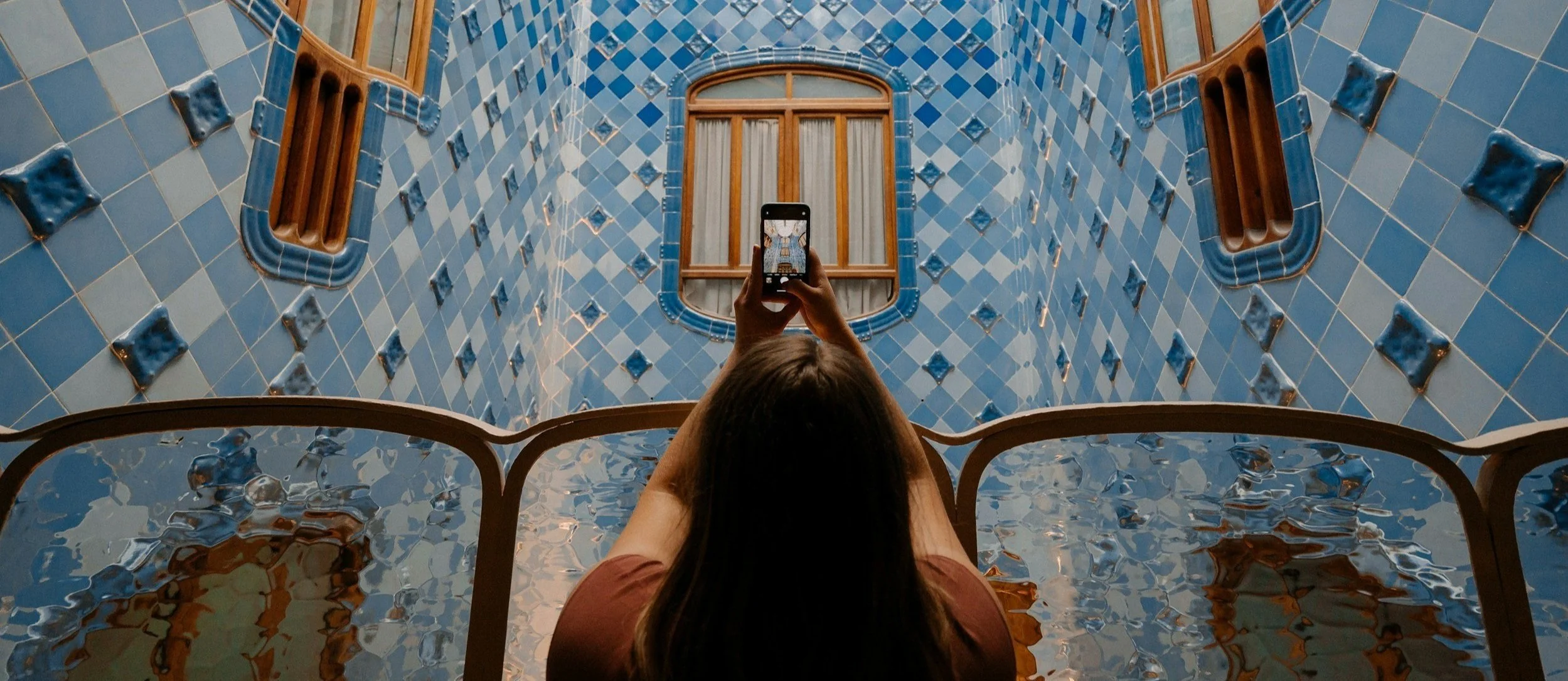TikTok Tourism: Are We Loving Places to Death?
We live in a social media age; in 2024 alone, Statista recorded that 5.22 billion of us are social media users - that equates to 63.8% of the world’s population. There have been many discussions, especially in current times, about social media and the impact it has on our lives. As with everything else in our society, there will always be debates about this topic and opinions will always differ.
However, there is a topic centred around the use of social media that I don't think people are addressing enough. In fact, I’d go as far as to say that many don’t even realise they are part of the issue - and the issue is this: the increase of TikTok tourism and the disrespect shown to our world's landscapes. I pose to you a somewhat philosophical question: do we destroy the places we love by sharing them on social media? Are we inadvertently contributing to the demise and over-development of destinations? Simply put, are we loving places to death?
Although the Tik-Tok ‘ban’ in the US has people wondering what effect this will have on other platforms and social usage, in 2024 Tik-Tok had over 1 billion monthly active users. It was also found by Search Logistics that 74% of Gen-Z use Tik-Tok as their default search engine; this gives a golden opportunity for attractions and DMOs (Destination Management Organisations) to utilise it to bring new potential customers and visitors every year. It is easy to see why big companies in the tourism industry love this for financial reasons, with 15-second videos of hotel chains, destinations, and travel guides getting as much as 135k+ views per video. Think about it, how often do you see travel reels pop up on Instagram? Videos of exotic lands being explored, happy sun-drenched selfies in paradises, or 'top five restaurants you just HAVE to go to before you die'? Travel content is, without a doubt, lucrative, but what is the hidden cost of it all?
That cost is ‘overtourism’ - when a popular destination is visited by too many tourists causing negative impacts environmentally, economically, and sociologically – and it was the ‘buzzword’ of 2024 according to CNN Travel, with projections for 2025 in the tourism industry only expected to rise. In Spain alone, they hit new records in 2024 with a whopping 94 million international visitors flocking to the country, a 10% increase on 2023 numbers. The other change that has been recorded since 2023 is that 32% of these international visitors swapped beach holidays for culinary and cultural adventures in the country instead. The more popular regions, such as Barcelona, Valencia, and the Canary Islands are already worried about the growing strain on their infrastructure – both with the increase in tourism and recovering from last year’s catastrophic flooding. Although the revenue from this boom has made Spain’s economic outcome better off, residents of the country have voiced many frustrations over overcrowding, disrespectful tourist behaviour, and the strain it is all causing their housing market. It is not just the Spanish locals that are feeling the irritation of this vast increase in popularity, with many iconic landmarks now feeling the weight and the effect of it all.
Top 10 World Landmarks under the exertion of overtourism:
10. Venice, Italy – It is no secret that Venice is sinking but with the many millions of tourists visiting the country each year, the capacity is only accelerating its demise. During peak season, 80,000 tourists per day can visit the picturesque city, meaning that many tourist attractions become inaccessible.
9. Great Pyramids, Egypt – The Great Pyramids of Giza remain the only original of the seven wonders of the world, however, at the current rate of tourism, the accelerated deterioration means that it is well on its way to not being around for much longer. Overtourism has caused irreparable damage and attempts at repairing has only caused further damage.
8. Roman Colosseum, Italy – Rome’s Colosseum is certainly not what it used to be, with tourists adding further damage to the landmark by moving and stealing parts of the stones and graffitiing the remaining pillars.
7. Stonehenge, UK – We’ve all seen the TikTok videos of vandalism and damage done to this phenomenal landmark, with tourists also chipping away the stones. Several busy roadways close to the landmark also threaten the area.
6. Angkor Wat, Cambodia – While money from tourism is used to restore this structure, tourists are also the leading cause of its damage. Foot traffic and graffiti are the main sources of tourist destruction to the site.
5. Antarctica – This once-remote location is no longer quite so with the rise in cruise ship traffic increasing water pollution and threatening the continent’s coastline as well as the species that are inhabitant there.
4. Phi Phi Islands, Thailand – Since being featured in the 2000 film ‘The Beach’ the Phi Phi Islands have become a ‘bucket list’ destination; the clear waters and paradise beaches won’t last much longer however as with popularity comes resort developers.
3. Great Wall of China – Over the years approximately two-thirds of the Great Wall has been destroyed. This is largely due to the thousands of tourists that walk, vandalize, and graffiti it each year.
2. Machu Picchu, Peru – The massive influx of visitors to this Andes Mountain location has threatened the preservation of its ancient archaeology. The government has limited numbers to 2,500 per day however they are finding even that may be too many to prevent irreparable damage.
1. Galapagos Islands – This diverse ecosystem is incredibly fragile to outside influence, so much so it has been on the UNESCO World Heritage in Danger list since 2007.
There are signs of overtourism even closer to home here in the UK. I am a proud Scot and my homeland of Scotland is a hub for some of the most beautiful landmarks and scenery; from the expansive rolling mountains and wilderness in the Highlands and smaller islands to the bustling, historically bountiful cities, there is a lot to explore and capture. Sadly though, the impact of overtourism is becoming a blight to those who live here permanently with stunning landmarks, such as The Fairy Pools of the Isle of Skye, closing often due to the disrespectful behaviour of tourists, wanting the perfect capture for their socials and crossing boundaries that cause damage not only to the Pools but to the roads around it. Reportedly, in the summer of 2024, there were times when the people of the Isle of Skye were unable to get in and out of roads; people couldn't get to work or even medical appointments as the roads were clogged from morning to night.
Dr Guillem Colom-Montero of Glasgow University has been looking at the island of Majorca in Spain and the Scottish Highlands and Western Islands to gauge the impact of tourism. This is, at large, a study about how smaller islands are struggling with overtourism and how the locals are beginning to feel that they no longer recognise the places they have so fondly called home.
Overtourism has a huge impact on our environment. It can contribute to water overuse, environmental pollution, displacement of locals, leave a large carbon footprint, and can harm ocean health. With this in mind, it would seem then, that tourism and travelling need to start being observed and thought of as consumption.
The next question I would also like to ask is this, how is social media contributing to this and how can the narrative be changed?
Social media platforms have played a significant role in both motivating tourists to pick certain destinations to travel to and bringing previously obscure destinations into the limelight. Travel has increased significantly in the last decade and with the rise of smartphones and social media platforms, it has also become the most aspirational consumed media. It is not just an increase of travellers that comes from social media, but more so disrespectful behaviour for the country and landmarks that are being visited. The behaviour of travellers who are motivated by social media, especially ‘influencers,’ means that it is all about getting the shots and videos to boost their accounts and following. This can mean disrespecting locals, crossing boundaries, and inappropriate behaviour that unfortunately is becoming the norm. It doesn’t have to be holidays either, many local attractions are suffering the same issues, and although the revenue is great, the experience of those visiting becomes lesser and eventually there are losses instead of gains.
Something that I don’t often see, that should be going viral, is responsible and conscious travelling guides. Nature has been promoted so often for its mental health benefits and yet, we as a whole, are taking more liberties with its healing energies. We are using it more and respecting it much less. I am someone who connects with nature in big ways. I communicate often with trees; I feel the pain of the land, and see how the nature around us feels the disrespect it is facing. I don’t go out into nature much anymore between May – October as the sights make me irate. People come to local nature reserves, camping out in the beautiful wilderness, only to leave waste, trash, broken glass, disposable BBQs, tents, and fishhooks scattered all around the area. The care for the environment that gave them mental clarity and healing isn’t there at all and it truly doesn’t take much, it is nothing but arrogance and laziness.
The steps on a grand scale to help this crisis are vast, huge shifts in our infrastructures are needed and our governments need to start implementing harsher policies for tourism. There are small steps that everyone can take to make sure that things begin to improve:
Research the policies and traditions of the places you are going and make sure you adhere to all of them; it is not your country and you have no right to push boundaries.
If you are staying in an AirBnB or hotel, refuse daily housekeeping and travel with cotton linens for towels.
Say no to single-use plastics – bring your own reusable bags and bottles and buy in bulk.
Ensure that the money you spend in places is going towards the people who live in the community - eat locally for example.
Spend more time at the destination instead of multiple short trips.
Be aware of what you bring with you into environments; chemicals in some sunscreen, for example, are hazardous to the ocean.
If promoting locations on social media, please make sure to also promote responsible exploring and lead by example in doing so.
Our world is a magical place and one that is not built for consumption. Nature can give so much; it can recharge, it can heal, it can teach. But there will come a point when there is nothing left to give. Social media is a powerful tool, and that power needs to be respected. Overconsumption cannot become our legacy, especially when we are capable of so much more.
Written by Rochelle Hanslow
Rochelle Hanslow is a Scottish, neurodivergent, and chronically-ill writer, poet, and author. She talks to trees and dogs more than humans. Rochelle has written for magazines online and in print the likes of Happiful, Edition Dog, Mashable, Edition Dog Professional, and Conscious Being.
She is currently writing her first non-fiction book and seeking publication of her poetry pamphlets.








